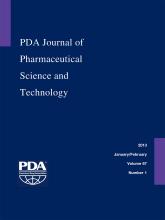Abstract
An accelerated lamellae formation (ALF) methodology has been developed to determine the delamination propensity and susceptibility of pharmaceutical glass vials. The ALF process consists of a vial wash and depyrogenation mimic procedure followed by stressing glass vials with 20 mM glycine pH 10.0 solution at 50 °C for 24 h and analyzing the resulting solutions by visual inspection for glass lamellae. ALF results demonstrate that while vial delamination propensity generally correlates with glass hydrolytic resistance, ALF is a more direct test of glass delamination propensity and is not affected by post-production vial washing that can affect results obtained using hydrolytic resistance tests. ALF can potentially be used by pharmaceutical companies to evaluate and screen incoming vial lots to minimize the risk of delamination during the shelf life of parenteral therapeutics, and by glass vial manufacturers to monitor and improve their vial manufacturing processes.
LAY ABSTRACT: Glass flakes can sometimes appear in liquid pharmaceutical drugs contained in glass vials. These glass flakes are a result of several factors related to the glass vial production process, glass vial sterilization procedures, and the formulation of the liquid pharmaceutical drug. Vial testing is routinely done in order to select glass vials that are less likely to form glass flakes. The factors leading to the formation of glass flakes were studied and applied to a method designed to directly screen vials for their propensity to form glass flakes. The washing of vials followed immediately by sterilization at high temperatures was determined to be a critical factor in the formation of glass flakes. As a result, a laboratory mimic of this procedure was incorporated into the newly developed method for screening vials. This mimic procedure as well as robust accelerated incubation conditions and a sensitive visual inspection procedure are key aspects of this vial screening method.
- Glass delamination
- Glass lamellae
- Accelerated lamellae formation
- Visual inspection
- Hydrolytic resistance
- Alkalinity
- Type I borosilicate glass
- © PDA, Inc. 2013
PDA members receive access to all articles published in the current year and previous volume year. Institutional subscribers received access to all content. Log in below to receive access to this article if you are either of these.
If you are neither or you are a PDA member trying to access an article outside of your membership license, then you must purchase access to this article (below). If you do not have a username or password for JPST, you will be required to create an account prior to purchasing.
Full issue PDFs are for PDA members only.
Note to pda.org users
The PDA and PDA bookstore websites (www.pda.org and www.pda.org/bookstore) are separate websites from the PDA JPST website. When you first join PDA, your initial UserID and Password are sent to HighWirePress to create your PDA JPST account. Subsequent UserrID and Password changes required at the PDA websites will not pass on to PDA JPST and vice versa. If you forget your PDA JPST UserID and/or Password, you can request help to retrieve UserID and reset Password below.






